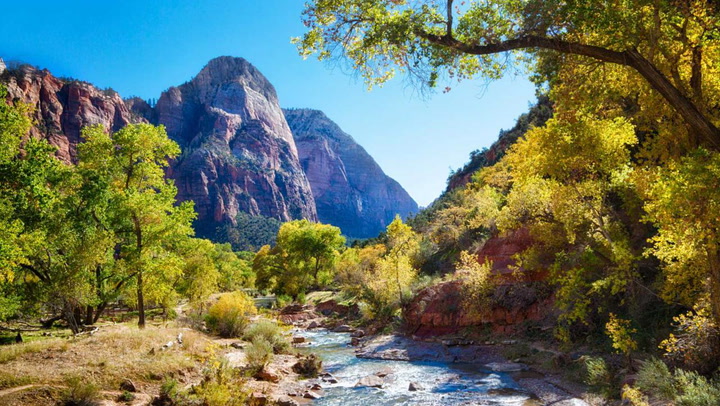Make the Most of Your National Park Visit
As of 2019, the United States is home to 61 national parks (and 418 national park sites), adding up to hundreds of thousands of acres of the great outdoors to explore.
Visiting a national park is a great way to spend a vacation in pretty much every season. Millions of people flock to some of the most popular parks in the nation, including Great Smoky Mountains National Park, Grand Canyon National Park, Rocky Mountain National Park, Yellowstone National Park, and Yosemite National Park, to name a few.
There’s practically a national park for everyone, whether you want to see the impressive Old Faithful at Yellowstone or marvel at General Sherman, the world’s largest tree, at Giant Forest of Sequoia and Kings Canyon National Park. Moreover, many of these parks offer a huge array of activities, like camping, hiking, biking, climbing, horseback riding, dogsledding, and stargazing. You can even catch a glimpse of the northern lights in some states, such as Denali National Park in Alaska.
The country’s beautiful national parks span a wide range of terrains beyond typical forests and mountains, including the smooth sands of White Sands National Park and the fascinating red and pink rock formations of Bryce Canyon National Park.
With so much to see and do, it’s easy to make a few mistakes that could prevent you from enjoying your national park vacation to the fullest.
Therefore, if you’re planning a trip to a national park, here are a few mistakes tourists often make and how to avoid them.
1. Not Planning Ahead
For any vacation, it’s always best to plan ahead. This is especially true for a national park trip. U.S. parks can vary in size and terrain; therefore, depending on what season you’re planning to visit, you can run into roadblocks, including huge crowds, unpredictable weather conditions, and park closures. It’s best to research your park before going, ensuring you’ve packed appropriately for the weather and have all the proper permits—especially if you plan on camping or visiting popular attractions. This also gives you an opportunity to figure out your schedule, enabling you to check off everything on your must-see list.
2. Improperly Interacting With Wildlife
National parks are perfect places to spot incredible wildlife, including bison, elk, bears, wolves, coyotes, big cats, and more. However, there is a right and wrong way to deal with wildlife, mostly involving giving the animals plenty of space so they don’t feel threatened.
3. Being Glued to Your Camera
While snapping those Instagram photos is important, it is crucial to remember that you’re in the great outdoors—the perfect place to unplug. Get your snaps, but also don’t forget to look up from the screen and take in the beauty for yourself.
4. Not Staying Out Late to See the Stars
Plenty of vacationers like to be on the go all day long. While you will definitely see amazing sights during the daytime, all that activity can leave you too exhausted to enjoy the night sky, which cuts you off from enriching experiences in national parks. Many parks hold events at night, making this the best time to glimpse a sky full of stars.
5. Not Getting Up Early to Watch the Sunrise
On the flip side, people who sleep in until noon may miss out on one of the best parts of being in the great outdoors: witnessing a stunning sunrise over the landscape. This magical moment is not to be missed.
6. Not Filling Up Your Gas Tank
National parks aren’t always easy to reach, especially if you’re running low on gas. Remember to fill up when you get the chance, and consider bringing extra tanks just in case.
7. Not Using Park Maps
Your phone’s GPS might not work if you’re out of the service area. Yes, you’ll find some spots that are connected, but if you’re out on the trails, you might need to rely on a good, old-fashioned paper map, which can usually be found in the visitor’s center.
8. Going Off the Trail
Staying safe while hiking should be a top priority. The National Park Service provides a list of essential items you should always pack for your national park visit, including clothing layers, flashlights, water, and extra food. Additionally, one safety guideline you shouldn’t ignore is going off-trail. Some parks allow off-trail travel, but these areas are best suited for experienced adventurers. Always stick to designated trails to stay safe.
9. Skipping the Visitor Center
The visitor center has a wealth of knowledge and resources about the park you’re visiting. It’s an excellent place to find maps and talk to park rangers who can provide information about special events, closures, and crucial details you need to know.
10. Only Going During Peak Season or Only Visiting the Most Popular Attractions
There’s a national park for every season. Some parks are best visited in the summer, while others shine in the fall. Discovering a time to go during the off-peak season can be rewarding, resulting in fewer crowds. Researching before your visit will pay off by allowing you to explore underrated areas that are equally spectacular.





